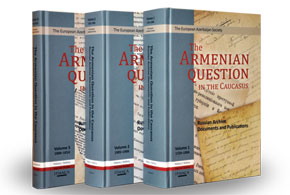 Pages 18-19
Pages 18-19George Bournoutian has written a review of The European Azerbaijan Society’s three-volume Armenian Question in the Caucasus - Russian Archive Documents and Publications in the Ararat magazine (www.araratmagazine.org). Although the efficient preparation and internet posting of a review so soon after publication of the lengthy three-volume set is admirable, its structure and content arouses both regret and wonder. Let us consider the review in the order it is written to provide a full picture of the issue.
This essential collection, the outcome of intensive scientific research in Russian archives and libraries (the Russian State Historical Archive and State Military History Archive), was first published in Baku (by the Elm publishing house) and then in St. Petersburg (the Academy of Cultural Research publishing house. Finally, the three-volume set was published in London (Ithaca Press).
Rather than getting down to a scientific and professional evaluation of the work, Bournoutian first of all attempts to induce a false impression of The European Azerbaijan Society, the compiler-authors and of the publishers. He essays political conclusions about both Society and authors from assumed – and false - premises. If this reviewer had adhered to the academic and ethical standards requisite for the provision of objective information, it would have been made clear that the Society carries out a range of academic and organizational work. Before publication of this three-volume set, The European Azerbaijan Society had, with the participation of well-known international scholars, realized publications (The Armenian-Azerbaijan conflict over Karabakh etc.) that earned great respect from the academic community. The Society publishes the magazine Visions of Azerbaijan with a combination of academic and popular articles on history and culture (see: www. visions.az). The team of compilers and writers includes academics and professional researchers who are specialists on the topic.
Following his initial notes, the reviewer comes to the question of whether documents published in the collection have been previously published, adopting an accusatory tone towards the compiler-authors rather than an academic assessment. A reader of the collection, however will have no problem in finding information about previous publication where that is the case. Both the cover and foreword of each volume indicate the number of documents issued for the first ti me. In Volume I, 11 of the 18 documents are presented for the first ti me (the exceptions being № 1, 2, 5, 6, 7, 8, 17), in Volume II, 14 of the 18 documents are newly in the public sphere (those previously issued being № 12, 13, 17, 18), in Volume III, 11 of the 14 documents are new (№ 4, 13 and 14 are not). In total, 36 of the 50 documents have been brought into the public domain for the first time. The necessity of adding the other documents to the collection is commented on in the foreword of Volume I:
Some public documents (a small number) from former, official publications such as the Imperial Decree of 10 November 1724 and the Turkmenchay Treaty of 10 February 1828, among others, are included in the collection in order to clarify matters touched upon in our project. (Volume I, page VI - VII).
Thus the reviewer, rather than conveying the reality, seems determined to create a false impression for readers. We are, by the way, familiar with the collection of documents compiled by Bournoutian himself. Regrettably, they do not conform to the general practice of providing copies of the original documents. This means that the reader has to trust the translation and, especially on contentious matters, there can be many a slip ’twixt translator’s eye and pen, to adapt an expression. Bournoutian’s next comment mentions the poorly written English introductions and comments. Well, clearly the foreword, introduction and comments were not originally in English and are translations. Of course, in any translation some ideas may not be expressed precisely as the writer intended, but our translator’s credentials are hard to contest. And we can all make mistakes to produce poor English; take two examples:
Aft er I examined the above-mentioned three volumes, however, it becomes clear that the main objective of the Society…
and
What the Azeris ignore to mention is that… Consistency of verb tense, Mr. Bournou- ti an?... ‘ignore to mention’!... But is this really the point?
It is accepted in scientific circles experienced in writing reviews of such publications as this three-volume set that issues directly related to the problem should be to the fore. However, while the collection is dedicated to the The Armenian Question in the Caucasus, the reviewer ignores this issue. Rather than attending to the book’s concept and content - the new information that it brings to research into the problem and related issues - he shift s the discussion to questions of Azerbaijani history. In so doing, he makes errors and gives misleading information about that, too. Unlike the reviewer, we will not distract readers’ attention from the problem under discussion and pursue those other errors here. We simply refer them to the seven-volume history of Azerbaijan (Baku, 1998-2006) and continue with the main topic.
The reviewer himself agrees that
It is true that Armenians formed a minority in the Yerevan and Nakhchivan regions until thousands of Armenians emigrated from Iran following the Turkmenchay Treaty
which was signed in 1828. Then, he says that they were the successors of Armenians deported by Shah Abbas. The period of Shah Abbas’s governance (1587-1629) is also well known to Azerbaijani historians. Consideration of the facts determines that the reviewer does not provide here an objective commentary on historical reality. Firstly, Shah Abbas’s policies were formed in the context of the Ottoman – Safavid wars of the ti me. Secondly, the population movements that took place on the territory of Azerbaijan involved Azerbaijanis. To clarify this issue, we need to find answers to the following questions:
a) Where did Shah Abbas settle the population removed from Azerbaijan?
b) From where were Armenians moved to the South Caucasus following the Turkmenchay Treaty?
The answers to these questions are so simple that it hardly needs a historian to answer to them. Shah Abbas moved the population mainly to Isfahan and surrounding territories, but the Armenians sett led in the South Caucasus were moved from the Ottoman Empire and South Azerbaijan. The Armenians themselves associated their movement to Northern Azerbaijan with the Turkmenchay Treaty of 1828. It is no accident that in 1978 they raised a monument dedicated to the 150th anniversary of their move to Nagorno Karabakh; why was that monument later obliterated?
The reviewer’s reference to Volume I, page 8, of the collection also fails to reflect reality. In order to prove it, we provide the quotation: I have charged Prince Abkhazov, chief of the Military District there, directly with the responsibility for resettling to Karabakh only those families who, living nearer to this province than to our other two newly acquired regions of the Araz, insist on being sett led in the Karabakh khanate.
It is clear from the quotation that these actions were planned, but it is not clear that this is what actually happened. Another of the reviewer’s errors concerns the commentary by Yefremov regarding materials in a description of the Karabakh province connected with the liquidation of the Karabakh khanate in 1822. The five mahals mentioned here, known to history as the Khamsa melikdoms – were Albanian melikdoms. The population of these melikdoms was later subjected to de-ethnization by the anti-Azerbaijan policy of the day. The famous Russian orientalist I.P.Petrushevski wrote that most Albanians gradually integrated with the Azerbaijani population and became Moslems, but some integrated with Armenians (in Sheki and Nagorno Karabakh) and were assimilated (Petrushevski I.P. Sketches...L, 1949, p.52).
The view that the documentation in the collection is incomplete may also not be considered fair comment. Based on generally accepted practice in publishing archive documents, we gave priority to those parts of the documents directly related to the problem. The abridgements are particularly noted. This was done in such a way that the content of each document would be absolutely clear.
The commentary on Peter I’s manifesto concerning Armenians is also misrepresented by the reviewer. The collection is about The Armenian Question; raising the Georgians here seems merely provocative.
The second volume of the collection provides information about the events of 1905- 1906, known as the Armenian-Moslem War and the compiler-authors refer to the tendentious documents from Russian government circles. Those events are viewed as very difficult pages in the histories of both nations, providing very important lessons. Unfortunately, a reviewer who is unwilling to see any positive thesis in the three-volume set adopts a negative stance here, too.
The essence of his position on the collection is disclosed at the end of the review, it concludes with false premises (propaganda war etc) which do not become an academic in a scientific discussion.
Thus, an analysis of the review under consideration shows that the reviewer could not approach the three-volume set of essential archive documents and materials and the profound scientific commentary offered as a professional historian. Rather than scientific argument he has preferred to offer political intrigue and provocation, deliberately attempting to undermine the results of intensive academic research. The compiler-authors are convinced that their work is on the right path and that further research into the archives and documents is required in this area.


